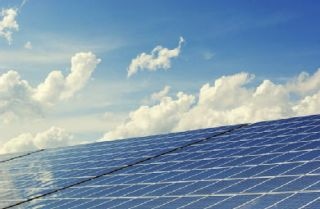Jul 30 2019
Solar cells and light-sensing technologies could be rendered more efficient by leveraging a unique property that results from defects and deformations in their structures.
 (Credit: University of Warwick)
(Credit: University of Warwick)
Scientists from the Department of Physics, University of Warwick, have discovered that the strain gradient (that is, inhomogeneous strain) in the solar cells, through physical force or produced during the fabrication process, is capable of preventing photoexcited carriers from recombining, resulting in an improved efficiency of solar energy conversion. The study outcomes have been reported in Nature Communications.
The research team used an epitaxial thin film of BiFeO3 grown on LaAlO3 substrate to find the effect of inhomogeneous deformation on the ability of the film to convert light into electricity by examining how its strain gradient influences its potential to isolate photoexcited carriers.
A majority of the commercial solar cells are produced with two layers that develop, at their boundary, a junction between two types of semiconductors, n-type with negative charge carriers (electrons) and p-type with positive charge carriers (electron vacancies).
Upon absorbing light, the junction of the two semiconductors experiences an internal field that splits the photoexcited carriers in opposite directions and produces a current and voltage across the junction. In the absence of such junctions, the energy cannot be tapped and the photoexcited carriers will just quickly recombine, thereby removing any electrical charge.
The scientists discovered that the strain gradient could help prevent recombination by isolating the light-excited electron-holes, thereby improving the conversion efficiency of the solar cells. The BiFeO3/LaAlO3 film also showed some exciting photoelectric effects, like persistent photoconductivity (enhanced electrical conductivity). It has prospective applications in transducers, actuators, and UV light sensors.
This work demonstrated the critical role of the strain gradient in mediating local photoelectric properties, which is largely overlooked previously. By engineering photoelectric technologies to take advantage of strain gradient, we may potentially increase the conversion efficiency of solar cells and enhance the sensitivity of light sensors.
Dr Mingmin Yang, University of Warwick
Yang continued, “Another factor to consider is the grain boundaries in polycrystalline solar cells. Generally, defects accumulate at the grain boundaries, which would induce photo-carrier recombination, limiting the efficiency.”
Yang further added, “However, in some polycrystalline solar cells, such as CdTe solar cells, the grain boundaries would promote the collection of photo-carriers, where the giant strain gradient might play an important role. Therefore, we need to pay attention to the local strain gradient when we study the structure-properties relations in solar cells and light sensor materials.”
It was previously believed that the influence of this strain on efficiency was negligible. With the growing technology miniaturization, the strain gradient’s effect becomes intensified at smaller sizes. Therefore, the magnitude of strain gradient could be markedly increased with the reduction in size of a device using one of these films.
Dr Yang continued, “The strain gradient induced effect, such as flexo-photovoltaic effect, ionic migration, etc, would be increasingly important at low dimensions.”
The study was financially supported by the Engineering and Physical Sciences Research Council (EPSRC), part of UK Research and Innovation.